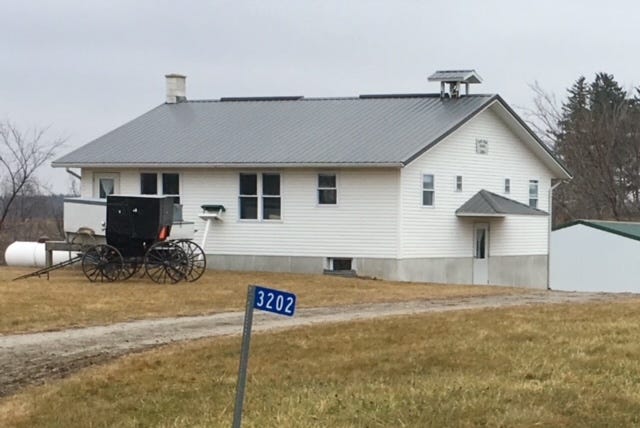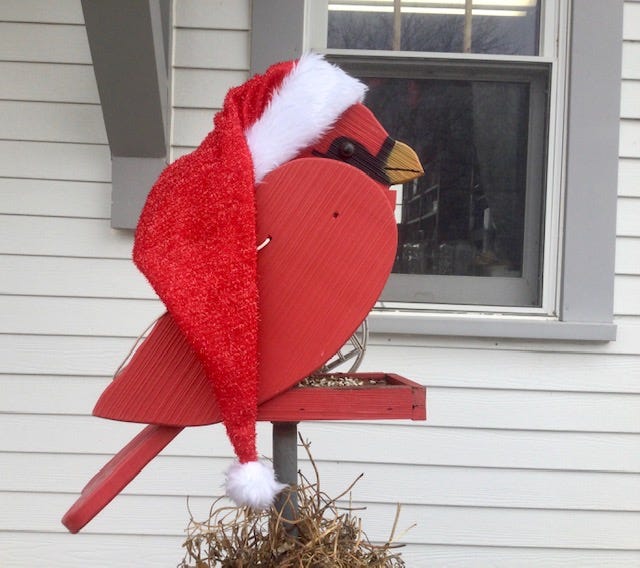No Santa Claus. No lights, no tinsel, no trees. Just a ring of buggies surrounding their Amish one-room schoolhouse, blankets thrown over the horses’ backs. I pulled into the yard in my car and parked. The animals waited patiently, taking a snort of the cold air, breath hanging in the mist, their hooves pawing the hard ground. A horse-drawn bench wagon was stationed near the side door, its contents empty: the low wooden foldable benches, song books, silverware and dishes, all carried into the school.
It was Christmas time in Buggy Land, a happy but plain celebration by Plain People. I’d wormed an invitation to this event from my neighbors, but wondered if I’d stepped over my bounds. So, I tried to remain as quiet and unobtrusive as I could.
Inside, the community was gathered in a dark basement, the only light from the small windows near the ceiling. A long table commanded the room, a table that had been magically assembled from benches, folded back and fitting together like a child’s brain teaser toy.
The table top was filled with casseroles of baked beans, mashed potatoes and gravy, noodles, cranberry sauce, three bean salad, rolls, orange tapioca and plates of cheese slices. Platters of turkey, roast beef, and fried chicken, complete with crispy wings and thighs, took up center stage, with tins of pumpkin, apple, and custard pie stationed around the edges.
It was Friday, the day the children were released from school for their Christmas vacation. The schoolhouse, the one community building the Amish possess, was the site of their communal Christmas gathering. Families would have smaller celebrations on Christmas Day in their homes.
The Amish have no church buildings, holding their services, weddings and funerals on their homesteads. They might clear out a barn, or a machine shed in the summer, or squeeze everyone in their district into their large basement in the winter. Church services rotate from farm to farm every two weeks, with one family hosting about two times a year.
In the schoolhouse basement, the men had piled their hats on the floor in a corner, the women hanging their bonnets from the school children’s coat pegs. Infants and toddlers, pre-teens and gangly teenagers filled in any blank spaces, the boys dressed in white shirts and black suspenders, the girls in solid-colored dresses—blues, grays, purple and green—with white prayer caps pinned to their heads.
Plates, cups, and silverware clanked and clicked together. The whole neighborhood filed past the table, balancing infants on their hips, knives, forks and spoons in their hands. They took their seats, men on one side of the room, women on the other, eating and chatting with good-natured ribbing.
Then the women began clearing the dishes, the men heading upstairs to arrange the benches. They pushed the small school desks to the sides of the room, unfolding the benches, lining them up, one behind the other in the cleared space. Christmas song books were passed around, most of the tunes in German. The community took their seats and I squeezed in next to a neighbor on a back bench where parents held babies on their laps. A lantern was lit. Little paper cut-out snowflakes, the only room decoration, twirled on strings from the ceiling.
“Number 22,” a voice called, and pages flipped in the songbooks, voices rising, men, women and children joining together three-part harmony:
Stille Nacht, heilige Nacht
I sang along, the hymn familiar, the words easy to pronounce. Heads turned, one neighbor after another smiling at me.
“She knows German!” I heard a woman whisper.
Not really, I thought to myself, but I can fake it.
“Number 10,” another voice called.
“Number 36.”
Im Stroh in der Krippe, kein Bett war im Raum
da lag’s Jesuskindlein, gar rein anzuschaun.
“Number 5.”
And so went the afternoon, the voices filling the schoolhouse, rising and falling, the familiar tunes sung a capella, without accompaniment, a pure sound that stood on its own, even though it might be slightly off-key at this moment or that. The voices blended perfectly in their imperfection, so many in the room related--son, daughter, siblings and cousins-- or at least from the same gene pool, all with the same vocal cords, stretching back to seventeenth-century Switzerland.
The voices spilled through the walls to the outside where the day dulled into early evening. The toddlers leaned against their mother’s arms, eyelids closing down. Young fathers rocked infants in their arms in the back of the room. A three-year old squirmed on his bench next to his mother. She wrapped her long arm around him and hugged him toward her.
Finally, the singing stopped, the lantern put out, and the benches were slipped back into the wagon. Slowly, through the dark, I fell in line behind a row of buggies rolling down the gravel road, following their red blinking reflective lights—oh, beautiful stars—toward home.
Listen to the podcast of this column with music by the Southeast Iowa Symphony and Iowa Wesleyan University Choir.
Now the Amish think I speak all languages. One year, Abram and Bertha, their children and grandchildren showed up on our doorsteps to carol in German, and my neighbor Donna and I sang Adeste Fideles back to them.
“Mary and I can sing a carol in a different language to you!” Donna said and motioned to me to join her in the hymn we sang in our Catholic parish as children.
The Amish were pleased. The teenagers whispered in Donna’s ear that they would like her to teach them our song. Clandestinely, they made their way to Donna’s living room the week before Christmas to learn the hymn. The teenagers had plans to sing the carol at their family Christmas dinner during the allotted time when the children entertained the adults with songs and skits. The teenagers slipped out of their houses in their buggies and parked them in Donna’s yard, tied to her hitching post.
“Pull the drapes, pull the drapes,” they told Donna, squeezed onto her living room sofa. They didn’t want their parents to drive by and see what they were doing. Never mind that their buggies were parked out front in the yard.
Quickly, the teenagers had the hymn down—all ten verses—and with the help of the internet, we sang the tune in several languages. In turn, the Amish teenagers eventually taught the carol to their parents. Adeste Fideles has now become part of their repertoire, the words written down in pencil at the back of their Christmas song books.
The following year, the carolers showed up again and I was ready with hot chocolate and cookies. About ten children lined up inside my house, pressing themselves against the wall, chocolate dripping out of their mouths, crumbs falling onto the floor. I always forget that the little ones don’t learn English until they go to one-room school, so we have to communicate through sign language.
Another cookie? I pointed to the plate of treats.
The parents shook their heads no, but the children nodded yes.
“They can share a cookie,” one of the young mothers said. “They don’t each need one.”
“No, they each need one,” I said, and the children grinned up at me.
I’d seen this sharing routine before. Once I gave a neighbor child a cookie for his birthday. He stuffed the cookie into his pocket.
Mmmm, I thought. Maybe he doesn’t like peanut butter cookies.
A bit disappointed, I drove the child home, and when we reached his kitchen, he took out the cookie, found a knife, and cut it into six pieces, one for each of his siblings. The whole family sat around their table and ate their cookie pieces. On his next birthday, I gave the boy six cookies.
“We have a surprise for you,” that same boy said, a Christmas cookie still in his hand. He lined up his siblings, and taking a deep breath, led the group in singing Silent Night in Spanish, his father’s hand squeezing his shoulder, the children’s voices, the same children who were just learning English, singing in yet another language, bright and clear.
Noche de paz, noche de amor,
Todo duerme en derredor.
Entre sus astros que esparcen su luz
Bella anunciando al niñito Jesús.
Brilla la estrella de paz,
Brilla la estrella de paz.
Wow! I clapped and applauded. “Bravo!”
The children smiled, clearly proud of their accomplishment.
The children sang the carol again and I tried to catch onto the words.
“Where did you learn that?” I asked. “Who taught you Spanish?”
“Oh, a man who comes to our produce stand,” the boy said. “We asked him to teach us.”
“Wonderful,” I said, imagining the scene, an immigrant from one of our near-by meat-packing plant towns pulling into Abram and Bertha’s lane to buy tomatoes, only to leave with a family of Amish children singing Silent Night to him in Spanish.
“Now, can you sing us a carol in another language, one we don’t know?” the boy asked.
“Another language?”
“You know all languages,” he insisted.
All languages? I thought. What had I done? This ruse had gone too far. But I rewound my mind to my childhood French class, and mustered out the words:
ll est né le divin enfant,
Jouez hautbois, résonnez musettes !
Il est né le divin enfant,
Chantons tous son avènement!
The Amish children and their parents looked at me with wonderment. I knew what was going through their heads: What is our strange English neighbor singing now? They showed no interest in learning this one. This wasn’t a familiar carol. Latin was easy, Spanish not bad, but French? Non, non, non.
Uh, oh, I thought. The next year, I knew that the Amish carolers were coming during Christmas week and that I would have to sing again. How had I gotten myself into this mess? I’d run through all the languages I knew, so what to do? What to do?
“The kids want to come to your house,” Martha had told me. “They really want to see you.”
I knew that this had to mean that they really wanted to see Banjo.
Banjo was my two-month-old standard poodle mix pup that I had bought from the Yutzys that fall. My last dog had died about five years before. After that, my work had me on the road a lot, so I thought best not to adopt another dog. Then the pandemic hit and I realized that I might now be off the road for the long run, so I started looking for another pup. I had several false starts, then Martha came over and said that Bonnie had had pups.
Bonnie was the Yutzy’s dog, a beautiful doodle who seemed perfect. She was friendly, even tempered and upbeat. Most days she stood in the door of the Yutzy’s greenhouse, ushering in customers. She was a canine Walmart greeter as if her tag read: Bonnie: People Greeter.
“The carts are here, would you like one?” She seemed to say. “The check-out counter is there. The bubblegum petunias are on sale today. Would you like me to lead you to them? “
I had thought several times: If only I could find a pup like Bonnie.
Then Bonnie had nine pups: red, white, brown and multi-colored little wiggly balls of fluff. Twice a day, the Yutzy children brought the pups out on the lawn and played with them, holding them in their laps, giving them treats, handling their ears and feet with enough pulled tails in the process to guarantee the little critters would become used to humans. “Good with children” seemed a given.
I knew the males could get large, so I narrowed down my choice to the four females. I had been a dog owner long enough to know that temperament trumped looks. I tried to resist the knock-down gorgeous pup who seemed shy. Instead, I set up a personality test my trainer had suggested.
I put a cardboard box on its side on the ground and threw in a few treats. Then we let the pups loose and a little red female bounced right in and took the treat. No hesitancy, no nervousness. She stood in the box, eating, and when she’d had her fill, she clearly saw that her siblings wanted in, so she stepped out and the others raced for the treats. When they had had their time of it, the red pup went back in and finished off the food.
“I’ll take her,” I told Martha. “She has confidence and spunk.”
I named the dog Banjo and had the chance to visit and play with her a couple of times a week until she was weaned and old enough to leave her mother.
Two months later, there the Yutzys were at my door, singing Christmas carols. I brought out Banjo and the children played and petted her, passing her around from child to child, just as they had done when she was tiny.
“Okay,” I said. “Now I have a song for you. It’s in English so you’ll understand the words.”
I picked up Banjo, waltzing around my porch steps. “This is an audience participation song,” I said. “When I point to you, bark.”
The Amish children’s eyes grew wide, but they seemed to understand.
How much is that doggie in the window?
(Woof, woof.)
The one with the waggly tail(Woof, woof.)
How much is that doggie in the window?
I do hope that doggie's for sale.
I read in the papers there are robbers
(Woof, woof.)
With flashlights that shine in the dark.(Woof, woof.)
If I had a doggie named Banjo,
She’d scare them away with one bark.I don't want a bunny or a kitty
I don't want a parrot that talks
I don't want a bowl of little fishies
You can't take a goldfish for a walk.How much is that doggie in the window?
(Woof, woof.)
The one with the waggly tail.(Woof, woof.)
How much is that doggie in the window?
I do hope that doggie's for sale.
Well, it wasn’t “Silent Night” in Italian or Norwegian, and I wasn’t Patty Page, but the performance seemed to do. Everyone on the porch joined in the chorus at the end--children, parents, and pup—and during the past year, whenever I saw the children, they asked me if I could sing the doggie song again.
Happy, Happy Holidays to All of You!
The symphony and choir on the podcast will send you to the heavens. Give it a listen.
I’m happy to be part of the Iowa Writers Collaborative. Please sample and support my fabulous colleagues:










This was a delight to read. I live in southern Iowa and am used to seeing Amish buggies. But to get this inside look at a Christmas celebration is a treasure. And the glimpse of family life, enviable in so many ways. Thank you for being the person who has these experiences and sharing them.
Oh, Mary, that is just beautiful and I can picture you singing to those children with such glee. Love to you and Banjo, and here's to a new year with many visits from friends and neighbors. I'll be knocking at your door one of these days, promise!